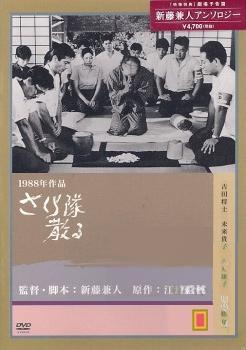Sakura-tai Chiru
- Original title
- Sakura-tai Chiru
- Year
- 1988
- Running time
- 118 min.
- Country
 Japan
Japan- Director
- Screenwriter
- Cast
-
Documentary
- Music
- Cinematography
- Producer
- Genre
- Documentary | Nuclear Holocaust. Historical Documentaries
- Synopsis
- A somber retrospective on the final days of the Sakura-tai theatrical troupe that had arrived in the island of Hiroshima to begin preparations for the staging of a play and, at 8:15 on the morning of August 6, 1945, became victims of the atomic bombing, Sakura-tai Chiru is a thoughtful examination of artistic imperative in a time of uncertainty and national crisis. Using the 1987 commemorative ceremony in Hiroshima and the dedication of a memorial to Sakurai-tai at Gohyaku-Rakanji Temple as a springboard to the re-examine the life and careers of the actors (and in particular, the troupe's director, renowned film and theater actor Sadao Maruyama who had appeared in such notable films as Mikio Naruse's Wife! Be Like a Rose!), the film is composed of a series of interviews with friends, family, and colleagues (among them, Nobuko Otawa, Eitaro Ozawa, Haruko Sugimura, and Osamu Takizawa) and re-enactments of the remaining survivors' tragic fate (four actors had survived the immediate bombing - Maruyama, Keiko Sonoi, Shozo Takayama, and Midori Naka - only to inevitably succumb to death days later). The film traces the evolution of the theatrical troupe within the context of Japanese history, from its early permutation as a government-mandated propaganda tool in the 1930s, to established actor, Maruyama's creative directorship of the splinter organization, to the Great Tokyo Air Raid of March 10, 1945 that caused several (predominantly male) actors to take indeterminate leaves of absence from the troupe in order to help their families (and city) rebuild, to the troupe's decision to send out two of the four remaining male actors in order to scout for replacement actors for their August Hiroshima engagement. These seemingly mundane operational decisions - to continue with the performance despite personal hardship and wartime uncertainty - would inevitably lead to the fate of Sakura-tai in light of the tragic context of world history. Tracing the fates of the four survivors as they sought the safety of family and friends after the atomic bombing only to endure lingering, agonizing deaths from incurable radiation poisoning, what emerges from the film's harrowing and deeply personal account is a sense of exploited and trivialized humanity in the face of military aggression and inhuman politics.
Note: A series of un-narrated photographic stills bearing only the Sakurai-tai actors' names and ages at the time of the bombing provide a simple, yet moving evocation of the human faces behind the senseless tragedy: Sadao Maruyama (age 44), Keiko Sonoi (age 32), Shozo Takayama (age 21), Midori Naka (age 36), Ayako Morishita (age 23), Kyoko Habara (age 22), Tsuyako Shimaki (age 22), Kiyo Komuro (age 30), Keiko Ryu (age 41).
- Movie Soulmates' ratings
-
Register so you can access movie recommendations tailored to your movie taste.
- Friends' ratings
-
Register so you can check out ratings by your friends, family members, and like-minded members of the FA community.
Is the synopsis/plot summary missing? Do you want to report a spoiler, error or omission? Please send us a message.
If you are not a registered user please send us an email to [email protected]
If you are not a registered user please send us an email to [email protected]
All copyrighted material (movie posters, DVD covers, stills, trailers) and trademarks belong to their respective producers and/or distributors.
For US ratings information please visit: www.mpaa.org www.filmratings.com www.parentalguide.org
 US
US  Canada
Canada  Mexico
Mexico  Spain
Spain  UK
UK  Ireland
Ireland  Australia
Australia  Argentina
Argentina  Chile
Chile  Colombia
Colombia  Uruguay
Uruguay  Paraguay
Paraguay  Peru
Peru  Ecuador
Ecuador  Venezuela
Venezuela  Costa Rica
Costa Rica  Honduras
Honduras  Guatemala
Guatemala  Bolivia
Bolivia  Dominican Rep.
Dominican Rep. 
